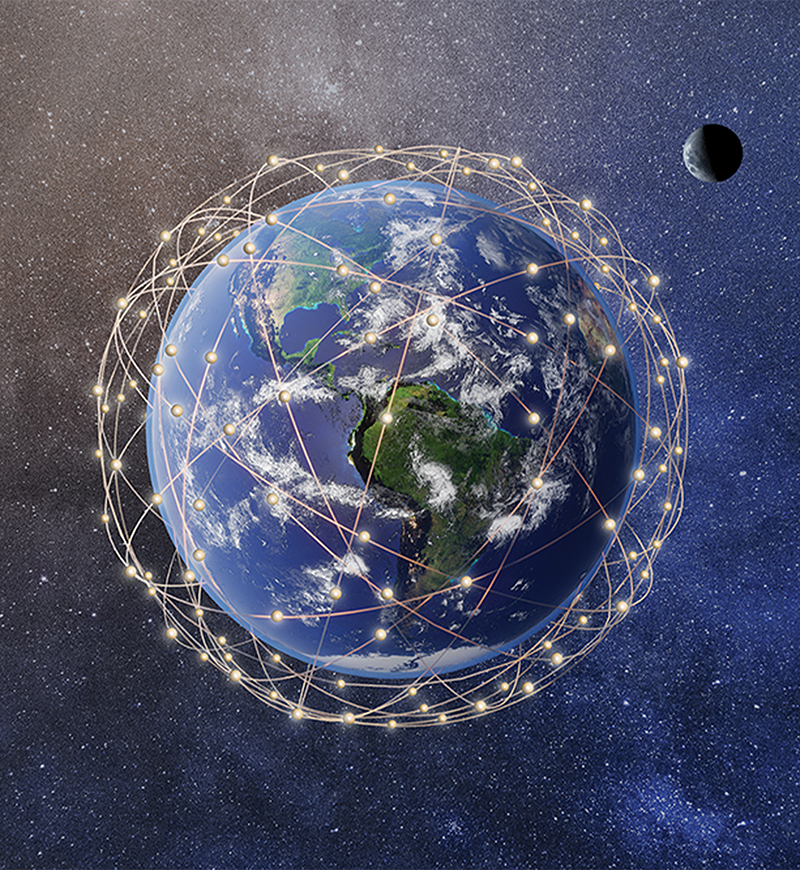Latest News

Rendering of Telesat’s Lightspeed LEO constellation. Photo: Telesat
Telesat is seeing a decline in revenue in its Geostationary Orbit (GEO) business in broadcasting with the increase in cord-cutting, and enterprise competition from SpaceX’s Starlink constellation. Yet Telesat is bullish on its own Low-Earth Orbit (LEO) constellation Lightspeed, and CEO Dan Goldberg told investors on Thursday that the operator is in conversation with the government of Canada for further funding for Lightspeed.
Telesat announced its full year 2023 financial results on Thursday. The company reported consolidated revenue of $704 million Canadian dollars ($520 million), a decline of 9% compared to 2022 when adjusted for changes in foreign exchange rates.
The decrease was due to the impact of the rate reduction with direct-to-home (DTH) customer Dish for capacity on the Anik F3 satellite secured in 2022, and a lower rate for a renewal with Bell Canada for the Nimiq 4 satellite signed in October 2023. In addition, Telesat made an equipment sale in 2022 to the U.S. Defense Advanced Research Projects Agency (DARPA) that was not repeated in 2023.
Telesat’s net income in 2023 was CA$583 million ($430 million), compared to a net loss of CA$82 million ($60.5 million) for the prior year. This was due to receiving CA$665 million ($490 million) in C-band clearing proceeds and positive variation in foreign exchange.
Adjusted EBITDA for the full-year 2023 was CA$534 million ($394 million), a decrease of 8% when adjusted for foreign exchange rates. Goldberg noted that adjusted EBITDA beat guidance.
More Decline GEO Expected in 2024
Telesat is expecting more revenue decline in this year, projecting to lose about CA$150 million ($111 million) in GEO business. Goldberg said decline is split between broadcast and enterprise. The broadcast market is facing cord-cutting, and the enterprise market is facing competition from Starlink. Maritime service revenue is most affected, he said.
“The biggest driver of lost revenue in the enterprise segment is the migration of customer requirements from GEO to LEO — namely to Starlink as they are the first in the market,” Goldberg said on a Thursday call with investors. “Enterprise customers want affordable, low latency broadband connectivity, which we’ve been talking about for quite some time. The transition to LEO is happening a little faster than even we expected. Although we don’t love seeing Starlink cannibalize some of our GEO customer requirements, it’s a strong validation of the market embrace of LEO and the compelling path that we’re on with Telesat Lightspeed.”
Telesat gave guidance for 2024, expecting between $545 million and $565 million ($402 million to $417 million) in revenue. Telesat expects to ramp up CapEx on Lightspeed in 2024, which will decrease Adjusted EBITDA relative to 2023 by about 34% at the midpoint of the guidance range.
Goldberg said Telesat’s focus in 2024 is maximizing Adjusted EBITDA and cash flow and mitigating revenue declines by “rigorously managing our legacy cost structure, while ramping up all activities associated with building and commercializing Telesat Lightspeed.”
Lightspeed Updates
Telsat reported it is going through “extensive engagement” with the government of Canada on further Lightspeed funding and expects to share funding terms shortly. Goldberg said that in addition to the $2 billion U.S. dollars of savings with the MDA contract, the company will need to borrow about $750 million U.S. dollars less than the prior Lightspeed plan.
“We’re very grateful for the strong support we’ve had from the government of Canada on the Lightspeed program,” Goldberg told investors. “There are a ton of people throughout the government of Canada who have worked really hard with Telesat and engage closely with us over the past few years. My colleagues and I appreciate all their hard work and commitment to the program.”
Telesat is moving forward with prime contractor MDA and Goldberg reported that Telesat completed the major system requirements review milestone with MDA and is progressing toward preliminary design review in the third quarter of this year.
Telesat plans to invest CA$1 billion into Lightspeed in 2024. Goldberg confirmed Telesat plans to launch its first satellites in about two years in June 2026 and offer data services shortly after, targeting full global coverage and service by the end of 2027.
Goldberg said Telesat is making progress with various antenna suppliers for LEO user terminals tailored toward different verticals, as well as landing station suppliers.
Part of the Lightspeed network plan is optical inter-satellite links (OISLs) onboard the satellites and Telesat has not yet announced the OISL supplier. Goldberg was asked if Telesat would consider purchasing optical inter-satellite links from SpaceX after SpaceX COO Gwynne Shotwell said last week at SATELLITE that Starlink plans to commercialize its laser terminals. Goldberg said Telesat has not had any conversations with Starlink about laser terminals.
Goldberg said Lightspeed will be competitive with Starlink as the network is differentiated for telcos, mobile network operators, corporations, governments, aero, and maritime customers.
“Unlike a service that’s principally a consumer-grade service, we have the ability to give customers SLAs [service level agreements], make commitments around CIR [committed information rate], and give our customers the ability to have their own dedicated bandwidth pools, which then they can manage,” Goldberg said. “It gives them massive flexibility and massive control over their network. That’s a big part of the differentiation.”
Stay connected and get ahead with the leading source of industry intel!
Subscribe Now